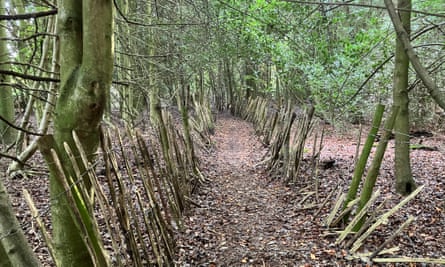
I am walking back into the 1980s on a mission to find a farm of my formative years. There, I attended an on-a-shoestring riding school, which made my toy “carpet farm” a reality. It was in Whitchurch-on-Thames, on the opposite bank of the River Thames to my childhood village, the other side of a magnificent, white-painted ironwork toll bridge that cost tuppence to cross on foot.
With a deepening scent of autumn in the air, we begin along Hartslock Bridleway, part of the modern Thames path and the ancient Tuddingway packhorse route, heading to the inland ports of Wallingford, Goring and Crowmarsh. Much of the view is now blocked by an 8ft-high fence around Coombe Park estate.
The path enters the wood on a cliff above the river. Either side are numerous shouty “Private – Keep Out” signs that have been scrawled over. We are only one big estate away from the location of the Right to Roam campaign group’s last major meeting.
We reach the locally infamous “slippery slope”. After a series of accidents, the council removed its rotting steps and handrail in 2011, without replacing them, rendering this part of a national trail unusable to everyone. Wet chalk makes for a treacherous surface. Thanks to a sustained campaign by Eric Hartley, a local access champion, the steps were replaced. Now in his 90s, Eric is a local hero, and these are now “the Hartley steps”.
We climb Hartslock Hill in warm sunshine, above the wide Thames, ribboning between the rounded hills of the Goring Gap that separate the Berkshire Downs from the Chilterns. There seems a ruby glow behind the green of everything, intensified in pockets, and seemingly carried in the colours of the red kites (beech leaf, willow and sweet chestnut) and buzzards (oak tannin, sycamore).
Descending to Old Reading cart track, the remembered freedom of Beech Wood is now a shoulder-width shuffle, flanked by a chestnut fence. Where it has collapsed, we walk, one behind the other, as if between the ribs of a wrecked ship.Then suddenly, there is the farm. Hidden now by 40-year-old conifers, it is the whaleback swell of the old barn roof I remember, and the hayloft, where we ate our lunch above the ponies eating theirs. There is the old metal field gate, with its flattened curlicue scroll. With it all comes the feeling of mutual cosiness: of keeping in safe from storms. All the ponies I led through it come cantering back, nuzzling my pockets for sugar among sticky tuppences, for the toll crossing back.



